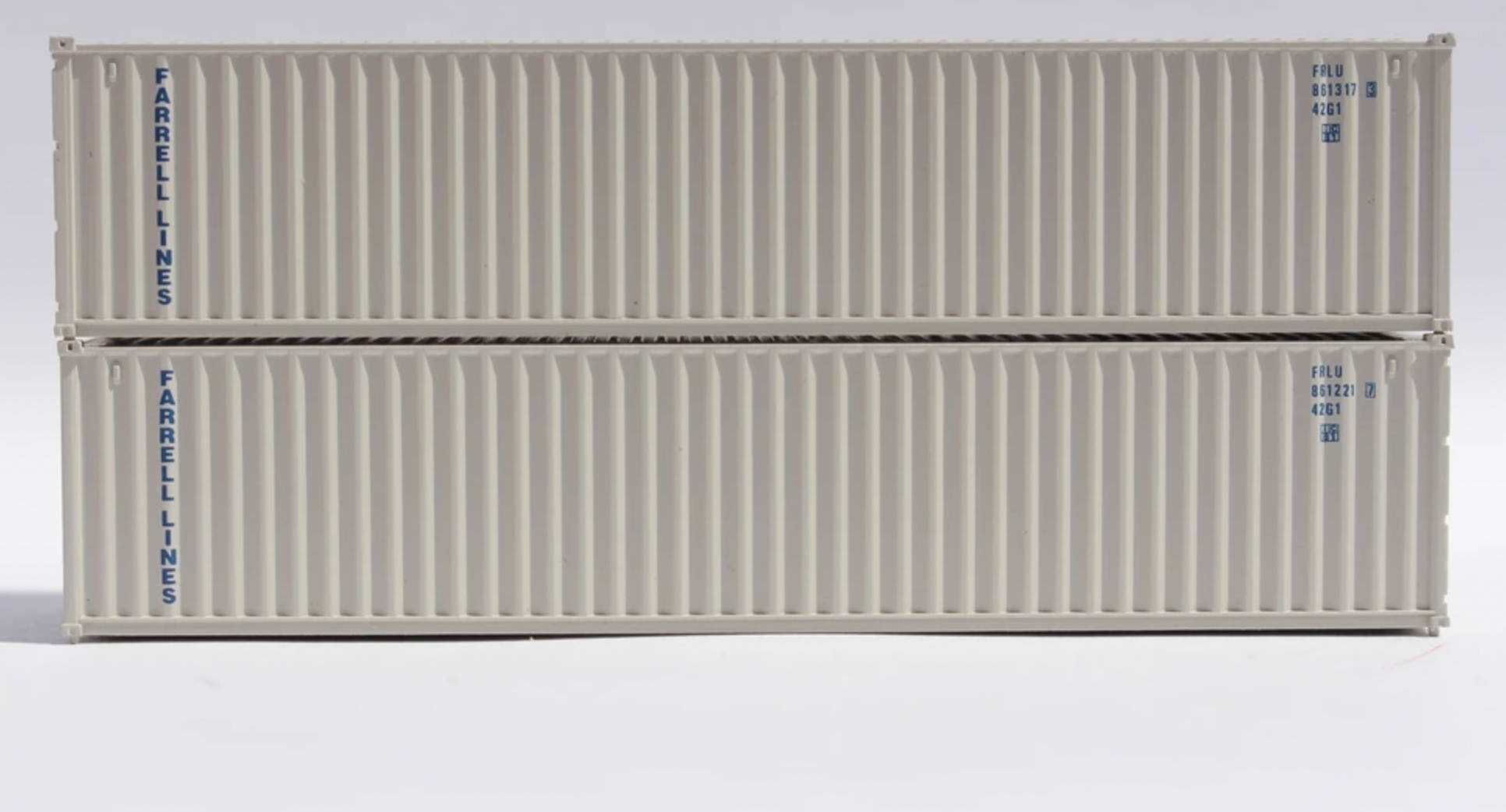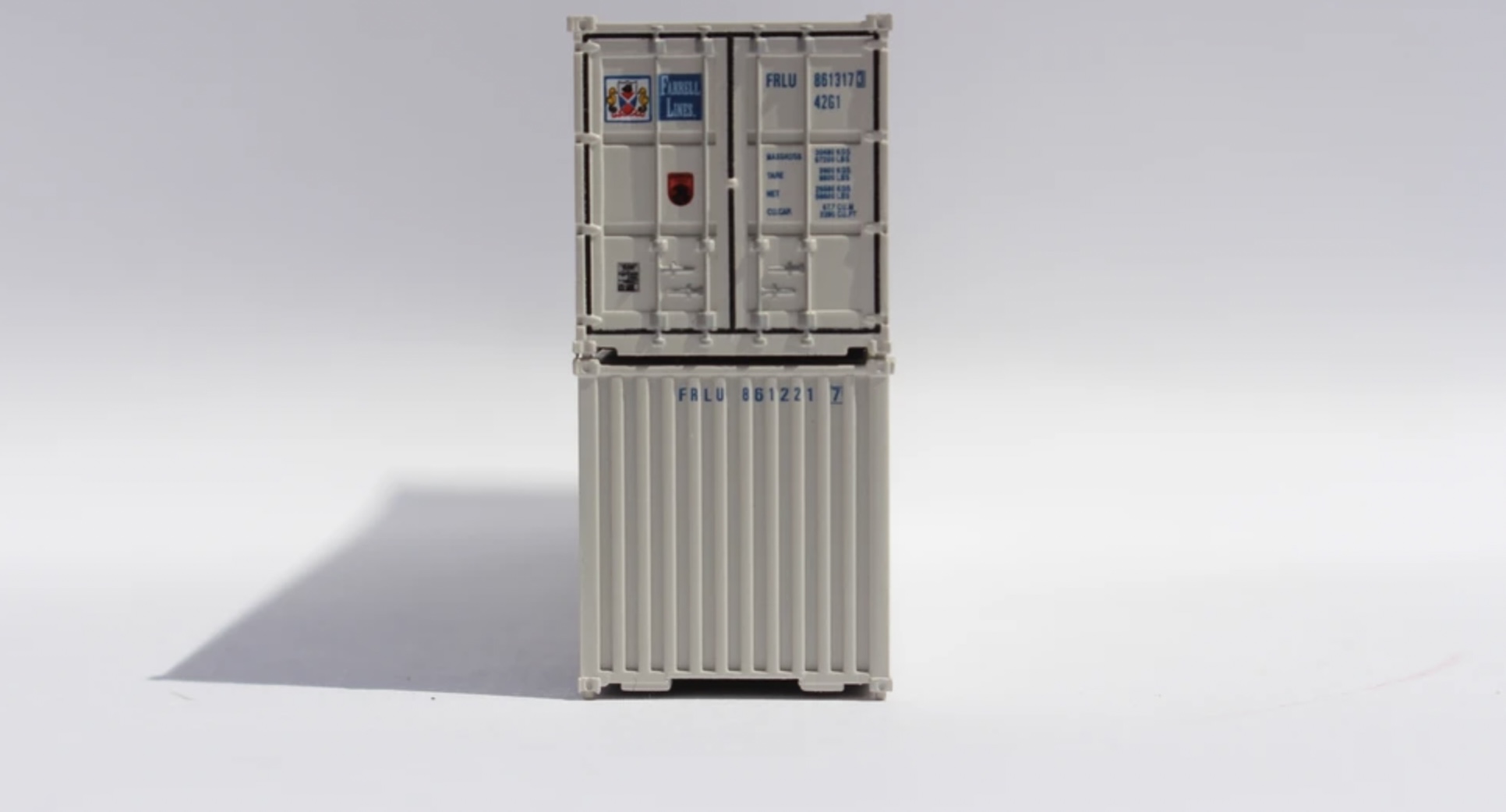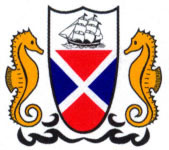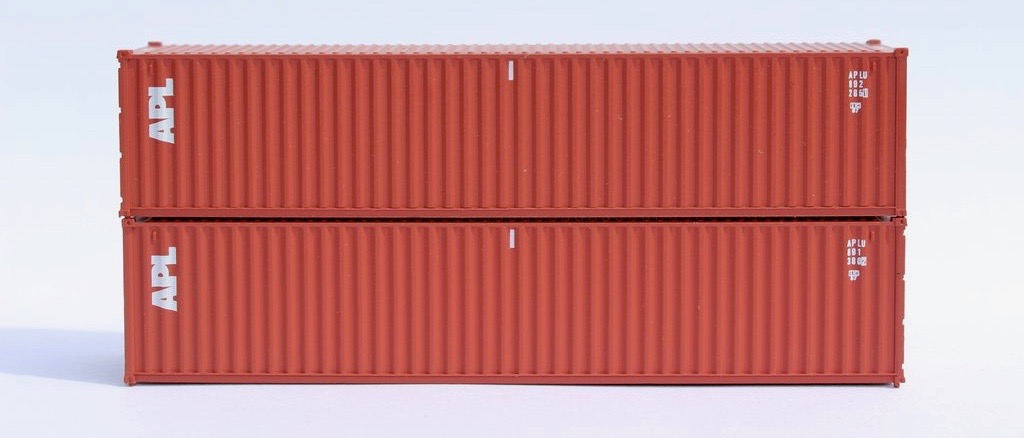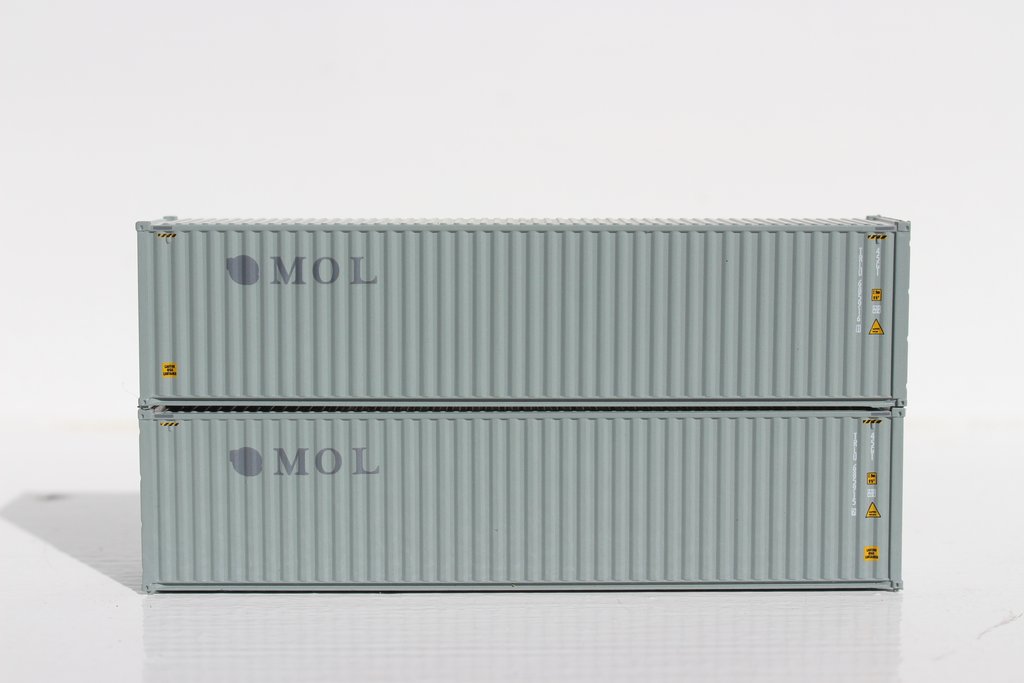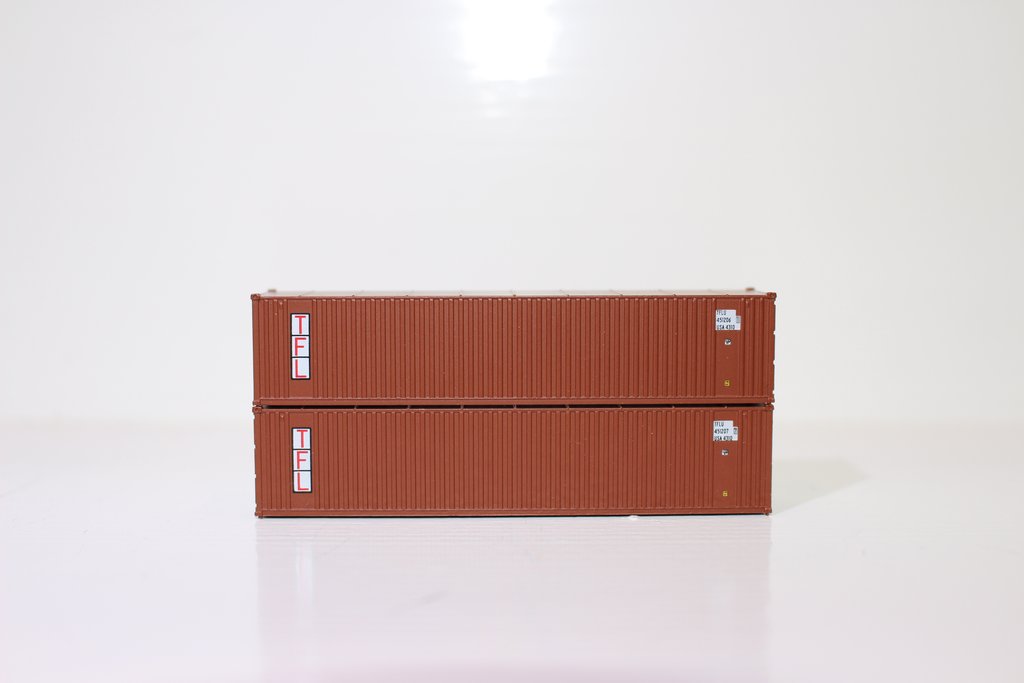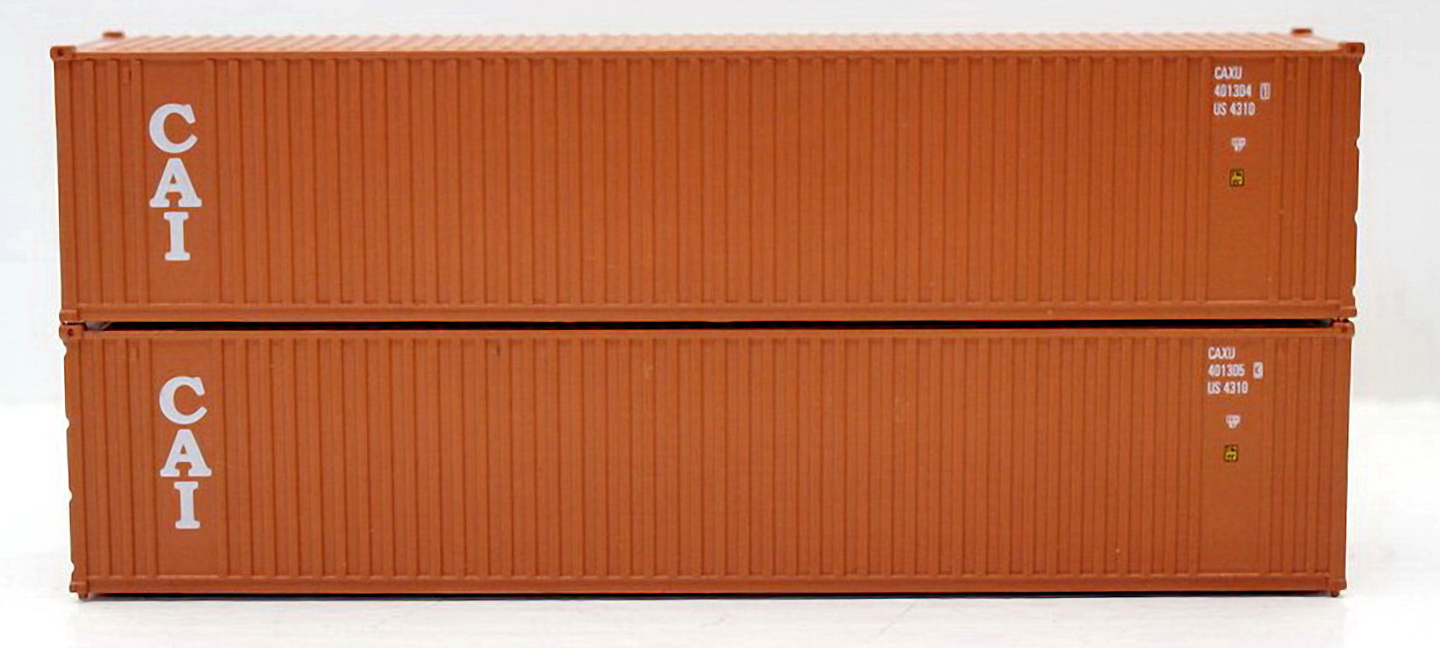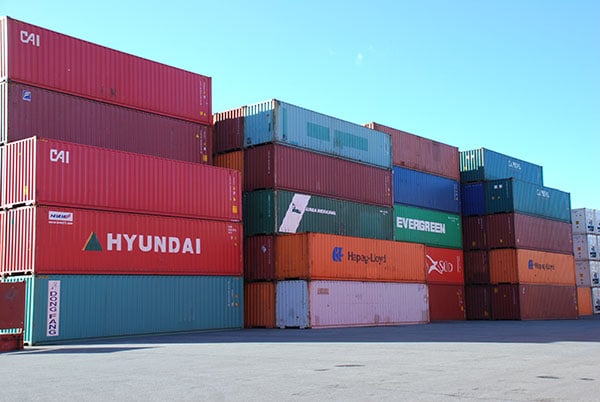Specific Item Information: FRLU 861221-7 & FRLU 861317-3
Model Information: All New Tooling; -42- corrugated sidesSeven different door variations tooled: molded as appropriate IBC(Inter-Box Connecting pins) in scale ISO locations JTC Magnetic connecting system: 3-magnets bottom & metal top plate Detailed printing as per photographs
Prototype History: The 40 foot container is the king of the container business. It is the most common standard container size used for international and domestic shipping. Most intermodal operations that handle overseas shipping are optimized for this container size. These containers are typically reinforced for loading, unloading and transportation by ship.
Dry containers are meant for non-refrigerated goods and hence are the most common type.
Corrugation in the construction of these containers yields much greater strength (just like with corrugated cardboard for boxes) but is more expensive to fabricate. Due to the extra strength granted by the corrugation, this is a popular type for overseas use.
Dry containers are meant for non-refrigerated goods and hence are the most common type.
Corrugation in the construction of these containers yields much greater strength (just like with corrugated cardboard for boxes) but is more expensive to fabricate. Due to the extra strength granted by the corrugation, this is a popular type for overseas use.
Road Name History: In 1965, Farrell Lines acquired the Australia-U.S. East Coast service from United States Lines. At this time Farrell also ceased offering passenger services, fixing their focus entirely onto the movement of cargo.
Following their 1965 acquisition, growth came along rapidly. Farrell Lines purchased another string of companies in 1975, the West-Coast Australia Service of the Pacific Far-East Line, and by 1978 Farrell Lines became the second largest U.S.-flag merchant fleet, 44 ships, with the acquisition of the entire American Export Line fleet.
When James Jr. and John passed away in 1978 and 1968, respectively, they had made Farrell Lines a top-tier U.S. flag company. They had upheld their father's legacy and ultimately handed the company down to other members of the Farrell family. But difficult financial times hit the company, and Farrell Lines dropped all of its African and European routes and sold 38 of its 44 ships. By 1991, Farrell Lines continued to operate with only four ships and catered solely to the Mediterranean and Persian Gulf.
Farrell Lines became a subsidiary of P&O Nedlloyd Container Line Ltd. in 2000, which was subsequently purchased by the A.P. Møller-Maersk Group in 2005. Following the purchase, Farrell Lines became a part of Maersk Line,Limited, the U.S. flag operating arm of the A.P. Møller-Maersk Group. Under Maersk Line, Limited.
Farrell Lines has reemerged as a U.S. flag roll-on, roll-off carrier. Seeing tremendous potential, Maersk Line, Limited revitalized the Farrell Lines brand in 2010 and increased the fleet to four ships.
Farrell Lines currently operates in partnership with Höegh Autoliners and its U.S. affiliate Alliance Navigation, focusing their efforts on transits between the U.S. East Coast and the Gulf of Mexico to the Middle East and Southwest Asia. Farrell Lines has also been able to sustain its tradition of leadership by participating in the Maritime Security Program (MSP) and the Voluntary Intermodal Sealift Agreement (VISA); both are important programs designed to support the Department of Defense in its sustainment of U.S. military forces to ensure the fleet is prepared in the event that emergency deployment is needed. As Farrell Lines continues to expand they will hold true to their mission of proudly serving our nation by carrying U.S. military cargoes on its pure car/truck vessels.
Following their 1965 acquisition, growth came along rapidly. Farrell Lines purchased another string of companies in 1975, the West-Coast Australia Service of the Pacific Far-East Line, and by 1978 Farrell Lines became the second largest U.S.-flag merchant fleet, 44 ships, with the acquisition of the entire American Export Line fleet.
When James Jr. and John passed away in 1978 and 1968, respectively, they had made Farrell Lines a top-tier U.S. flag company. They had upheld their father's legacy and ultimately handed the company down to other members of the Farrell family. But difficult financial times hit the company, and Farrell Lines dropped all of its African and European routes and sold 38 of its 44 ships. By 1991, Farrell Lines continued to operate with only four ships and catered solely to the Mediterranean and Persian Gulf.
Farrell Lines became a subsidiary of P&O Nedlloyd Container Line Ltd. in 2000, which was subsequently purchased by the A.P. Møller-Maersk Group in 2005. Following the purchase, Farrell Lines became a part of Maersk Line,Limited, the U.S. flag operating arm of the A.P. Møller-Maersk Group. Under Maersk Line, Limited.
Farrell Lines has reemerged as a U.S. flag roll-on, roll-off carrier. Seeing tremendous potential, Maersk Line, Limited revitalized the Farrell Lines brand in 2010 and increased the fleet to four ships.
Farrell Lines currently operates in partnership with Höegh Autoliners and its U.S. affiliate Alliance Navigation, focusing their efforts on transits between the U.S. East Coast and the Gulf of Mexico to the Middle East and Southwest Asia. Farrell Lines has also been able to sustain its tradition of leadership by participating in the Maritime Security Program (MSP) and the Voluntary Intermodal Sealift Agreement (VISA); both are important programs designed to support the Department of Defense in its sustainment of U.S. military forces to ensure the fleet is prepared in the event that emergency deployment is needed. As Farrell Lines continues to expand they will hold true to their mission of proudly serving our nation by carrying U.S. military cargoes on its pure car/truck vessels.
Brand/Importer Information: Now featuring our new line of 1:160 scale models. Developed using the latest in global technology & CAD systems, these New 2017 tooled models feature IBC connecting pins AND our Magnetic connecting system, and are decorated with detailed prototype printing. Our JTC container series of models offer Multiple door styles and variants to match prototypes. The First release is a 'Rib-style' corrugated side Canvas/Open top container, Now In Stock. Our second release is the more common 'wave' corrugation sides version, expected January 2018. Both are New to N scale. Release styles 3 & 4 will be around March 2018, and will be 2 of the most popular container styles in use. Please read our 'Latest News' section for updates. Thank You for visiting. New Facebook page: www.facebook.com/JTCmodeltrains
Item created by: CNW400 on 2021-10-16 13:02:32. Last edited by CNW400 on 2021-10-16 13:28:21
If you see errors or missing data in this entry, please feel free to log in and edit it. Anyone with a Gmail account can log in instantly.
If you see errors or missing data in this entry, please feel free to log in and edit it. Anyone with a Gmail account can log in instantly.


